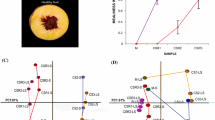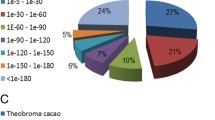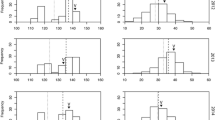Abstract
The ChillPeach database was developed to facilitate identification of genes controlling chilling injury (CI), a global-scale post-harvest physiological disorder in peach. It contained 7,862 high-quality ESTs (comprising 4,468 unigenes) obtained from mesocarp tissues of two full-sib progeny contrasting for CI, about 48 and 13% of which are unique to Prunus and Arabidopsis, respectively. All ESTs are in the Gateway® vector to facilitate functional assessment of the genes. The data set contained several putative SNPs and 184 unigenes with high quality SSRs, of which 42% were novel to Prunus. Microarray slides containing 4,261 ChillPeach unigenes were printed and used in a pilot experiment to identify differentially expressed genes in cold-treated compared to control mesocarp tissues, and in vegetative compared to mesocarp tissues. Quantitative RT-PCR (qRT-PCR) confirmed microarray results for all 13 genes tested. The microarray and qRT-PCR analyses indicated that ChillPeach is rich in putative fruit-specific and novel cold-induced genes. A website (http://bioinfo.ibmcp.upv.es/genomics/ChillPeachDB) was created holding detailed information on the ChillPeach database.


Similar content being viewed by others
References
Aranzana MJ, Pineda A, Cosson P, Dirlewanger E, Ascasibar J, Cipriani G et al (2003) A set of simple-sequence repeat (SSR) markers covering the Prunus genome. Theor Appl Genet 106:819–825
Bruhn CM, Feldman N, Garlitz C, Hardwood J, Ivan E, Marshall M et al (1991) Consumer perceptions of quality: apricots, cantaloupes, peaches, pears, strawberries, and tomatoes. J Food Qual 14:187–195. doi:10.1111/j.1745-4557.1991.tb00060.x
Carninci P, Shibata Y, Hayatsu N, Sugahara Y, Shibata K, Itoh M et al (2000) Normalization and substraction of cap-trapper-selected cDNAs to prepare full-length cDNA libraries for rapid Discovery of new genes. Genome Res 10:1617–1630. doi:10.1101/gr.145100
Childs KL, Hamilton JP, Zhu W, Ly E, Cheung F, Wu H et al (2007) The TIGR plant transcript assemblies database. Nucleic Acids Res 35:D846–D851. doi:10.1093/nar/gkl785
Chou HH, Holmes MH (2001) DNA sequence quality trimming and vector removal. Bioinformatics 17:1093–1104. doi:10.1093/bioinformatics/17.12.1093
Crisosto CH (2006) Short-term approaches to increase peach fruit consumption. Compact Fruit Tree 39:11–14
Dirlewanger E, Graziano E, Joobeur T, Garriga-Caldere F, Cosson P, Howard W et al (2004) Comparative mapping and marker assisted selection in Rosaceae fruit crops. Proc Natl Acad Sci USA 101:9891–9896. doi:10.1073/pnas.0307937101
Consortium ESTree (2005) Development of an oligo-based microarray (μPEACH 1.0) for genomics studies in peach fruit. Acta Hortic 682:263–268
Everstz EM, Au-Young J, Ruvolo MV, Lim AC, Raynolds MA (2001) Hybridization cross-reactivity within homologous gene families on glass cDNA microarrays. Biotechniques 31:1182–1192
Ewing B, Green P (1998) Base-calling of automated sequencer traces using phred. II. Error probabilities. Genome Res 8:186–194
Ewing B, Hillier L, Wendl MC, Green P (1998) Base-calling of automated sequencer traces using phred. I. Accuracy assessment. Genome Res 8:175–185
Folta KM, Staton M, Stewart PJ, Jung S, Bies DH, Jesdurai C et al (2005) Expressed sequence tags (ESTs) and simple sequence repeat (SSR) markers from octoploid strawberry (Fragaria x ananassa). BMC Plant Biol 5:12. doi:10.1186/1471-2229-5-12
Forment J, Gilabert F, Robles A, Conejero V, Nuez F, Blanca JM (2008) EST2uni: an open, parallel tool for automated EST analysis and database creation, with a data mining web interface and microarray expression data integration. BMC Bioinformatics 9:5. doi:10.1186/1471-2105-9-5
Grimplet J, Romieu C, Audergon J-M, Marty I, Albagnac G, Lambert P et al (2005) Transcriptomic study of apricot fruit (Prunus armeniaca) ripening among 13, 006 expressed sequence tags. Physiol Plant 125:281–292. doi:10.1111/j.1399-3054.2005.00563.x
Horn R, Lecouls AC, Callahan A, Dandekar A, Garay L, McCord P et al (2005) Candidate gene database and a transcript map for peach, a model species for fruit trees. Theor Appl Genet 110:1419–1428. doi:10.1007/s00122-005-1968-x
Howad W, Yamamoto T, Dirlewanger E, Testolin R, Cosson P, Cipriani G et al (2005) Mapping with a few plants: using selective mapping for microsatellite saturation of the Prunus reference map. Genetics 171:1305–1309. doi:10.1534/genetics.105.043661
Iseli C, Jongeneel CV, Bucher P (1999) ESTScan: a program for detecting, evaluating, and reconstructing potential coding regions in EST sequences. In: Proceedings of the 7th international conference on intelligent systems for molecular biology. AAAI Press, Menlo Park, pp 138–148
Lurie S, Crisosto CH (2005) Chilling injury in peach and nectarine. Postharvest Biol Technol 37:195–208. doi:10.1016/j.postharvbio.2005.04.012
Meisel L, Fonseca B, González S, Baeza-Yates R, Cambiazo B, Campos R et al (2005) A rapid and efficient method for purifying high quality total RNA from peaches (Prunus persica) for functional genomics analysis. Biol Res 38:83–88
Newcomb RD, Crowhurst RN, Gleave AP, Rikkerink EHA, Allan AC, Beuning LL et al (2006) Analysis of expressed sequence tags from apple. Plant Physiol 141:147–166. doi:10.1104/pp. 105.076208
Ogundiwin EA, Peace CP, Gradziel TM, Dandekar AM, Bliss FA, Crisosto CH (2007) Molecular genetic dissection of chilling injury in peach fruit. Acta Hortic 738:633–638
Ogundiwin EA, Peace CP, Nicolet CM, Rashbrook VK, Gradziel TM, Bliss FA et al (2008) Leucoanthocyanidin dioxygenase gene (PpLDOX): a potential functional marker for cold storage browning in peach. Tree Genet Genomes 4:543–554. doi:10.1007/s11295-007-0130-0
Peace CP, Ahmad R, Gradziel TM, Dandekar AM, Crisosto CH (2005a) The use of molecular genetics to improve peach and nectarine post-storage quality. Acta Hortic 682:403–409
Peace CP, Crisosto CH, Gradziel TM (2005b) Endopolygalacturonase: a candidate gene for Freestone and Melting flesh in peach. Mol Breed 16:21–31. doi:10.1007/s11032-005-0828-3
Peace CP, Crisosto CH, Garner DT, Dandekar AM, Gradziel TM, Bliss FA (2006) Genetic control of internal breakdown in peach. Acta Hortic 713:489–496
Pertea G, Huang X, Liang F, Antonescu V, Sultana R, Karamycheva S et al (2003) TIGR Gene Indices clustering tools (TGICL): a software system for fast clustering of large EST datasets. Bioinformatics 19:651–652. doi:10.1093/bioinformatics/btg034
Suzek BE, Huang H, McGarvey P, Mazumder R, Wu CH (2007) UniRef: comprehensive and non-redundant UniProt reference clusters. Bioinformatics 23:1282–1288. doi:10.1093/bioinformatics/btm098
Tusher VG, Tisbshirani R, Chu G (2001) Significance analysis of microarrays applied to the ionizing radiation response. Proc Natl Acad Sci USA 98:5116–5121. doi:10.1073/pnas.091062498
Van Gelder RN, von Xastrow ME, Yol A, Dement DC, Barchas JD, Eberwine JH (1990) Amplified RNA synthesized from limited quantities of heterogeneous cDNA. Proc Natl Acad Sci USA 87:1663–1667. doi:10.1073/pnas.87.5.1663
Zhulidov PA, Bogdanova EA, Shcheglov AS, Vagner LL, Khaspekov GL, Kozhemyako VB et al (2004) Simple cDNA normalization using Kamchatka crab duplex-specific nuclease. Nucleic Acids Res 32(3):E37. doi:10.1093/nar/gnh031
Acknowledgements
We thank Dr. Abhaya Dandekar for critical review of the manuscript. This research was funded by UC Discovery Grant (bio05-10527) with the Industry-University Cooperative Research Program.
Author information
Authors and Affiliations
Corresponding author
Additional information
Ebenezer A. Ogundiwin and Cristina Martí contributed equally to this publication.
Electronic Supplementary Material
Rights and permissions
About this article
Cite this article
Ogundiwin, E.A., Martí, C., Forment, J. et al. Development of ChillPeach genomic tools and identification of cold-responsive genes in peach fruit. Plant Mol Biol 68, 379–397 (2008). https://doi.org/10.1007/s11103-008-9378-5
Received:
Accepted:
Published:
Issue Date:
DOI: https://doi.org/10.1007/s11103-008-9378-5




